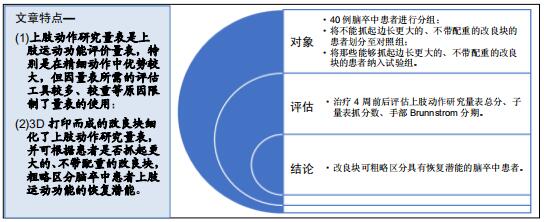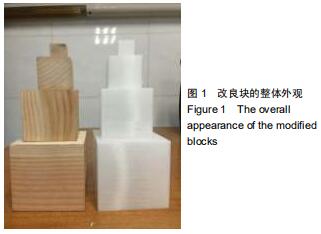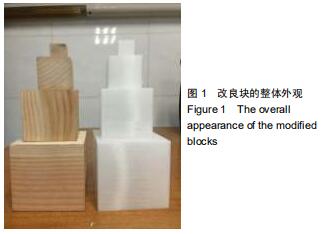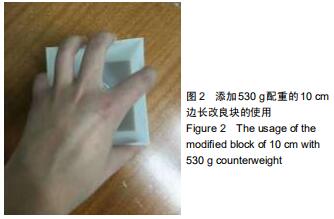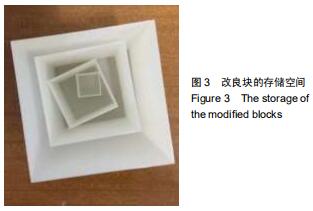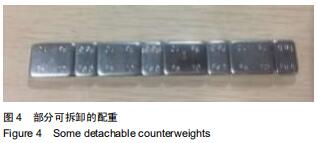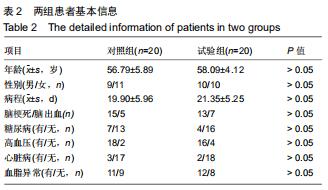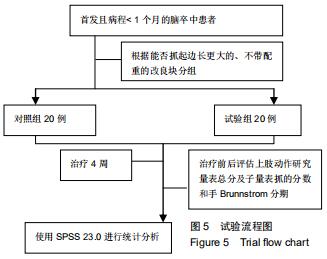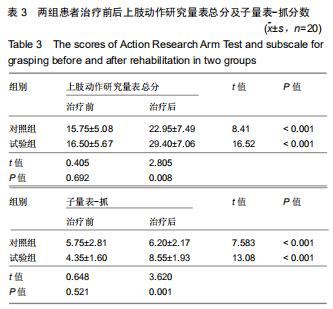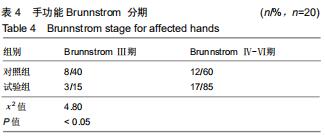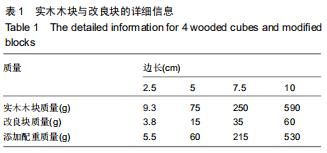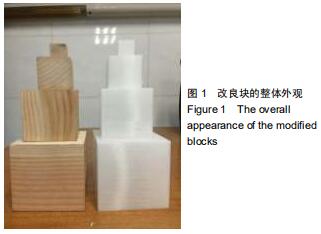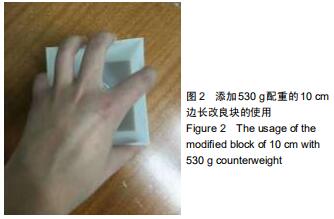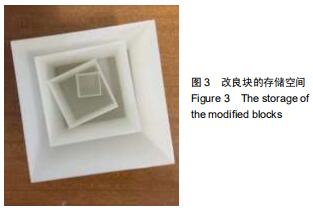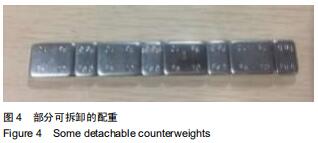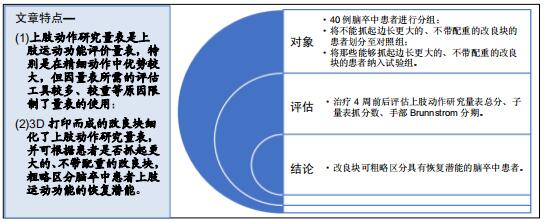|
[1] LI Z, JIANG Y, LI H, et al. China's response to the rising stroke burden. BMJ. 2019;364:l879.
[2] ZENG W, GUO Y, WU G, et al. Mirror therapy for motor function of the upper extremity in patients with stroke: A meta-analysis. J Rehabil Med. 2018;50(1):8-15.
[3] HOU S, IVANHOE C, LI S. Botulinum Toxin Injection for Spastic Scapular Dyskinesia After Stroke: Case Series. Medicine (Baltimore). 2015;94(32):e1300.
[4] 王海桥,鲍春龄,李鹤,等.针刺联合运动想象对脑卒中软瘫上肢精细动作的影响[J].中国针灸,2015,35(6):534-538.
[5] BHAKTA BB, HARTLEY S, HOLLOWAY I, et al. The DARS (Dopamine Augmented Rehabilitation in Stroke) trial: protocol for a randomised controlled trial of Co-careldopa treatment in addition to routine NHS occupational and physical therapy after stroke. Trials. 2014;15:316.
[6] 瓮长水,王军,王刚,等.上肢动作研究量表在脑卒中患者中的信度[J].中国康复理论与实践,2007,13(9):868-869.
[7] 瓮长水,王军,潘小燕,等.上肢动作研究量表在脑卒中患者中的效度[J].中国康复理论与实践,2008,14(1):53-54.
[8] LYLE RC. A performance test for assessment of upper limb function in physical rehabilitation treatment and research. Int J Rehabil Res. 1981;4(4):483-492.
[9] CARROLL D. A quantitative test of upper extremity function. J Chronic Dis. 1965;18:479-491.
[10] YOZBATIRAN N, DER-YEGHIAIAN L, CRAMER SC. A standardized approach to performing the action research arm test. Neurorehabil Neural Repair. 2008;22(1):78-90.
[11] HUANG CY, LIN GH, HUANG YJ, et al. Improving the utility of the Brunnstrom recovery stages in patients with stroke: Validation and quantification. Medicine (Baltimore). 2016; 95(31):e4508.
[12] CHEN CL, CHEN CY, CHEN HC, et al. Responsiveness and minimal clinically important difference of Modified Ashworth Scale in patients with stroke. Eur J Phys Rehabil Med. 2019; 55(6):754-760.
[13] 贾朋,孙峰,薛世峰,等.基于3D打印的复杂井筒模拟岩样制作[J].实验室研究与探索,2019,38(7):73-76.
[14] 徐伟业,陈维平,金枫,等.基于数值模拟和砂型3D打印的机匣整体重力铸造工艺研究[J].铸造,2019,68(8):905-910.
[15] LI N, LI Y, LIU S. Rapid prototyping of continuous carbon fiber reinforced polylactic acid composites by 3D printing. Journal of Materials Processing Technology. 2016;238:218-225.
[16] AMANO S, UMEJI A, UCHITA A, et al. Clinimetric properties of the action research arm test for the assessment of arm activity in hemiparetic patients after stroke. Top Stroke Rehabil. 2020;27(2):127-136.
[17] KLAUER C, FERRANTE S, AMBROSINI E, et al. A patient-controlled functional electrical stimulation system for arm weight relief. Med Eng Phys. 2016;38(11):1232-1243.
[18] MOFTAH M, JADAVJI NM. Role of behavioral training in reducing functional impairments after stroke. Neural Regen Res. 2019;14(9):1507-1508.
[19] NELSON CM, MURRAY WM, DEWALD JPA. Motor Impairment-Related Alterations in Biceps and Triceps Brachii Fascicle Lengths in Chronic Hemiparetic Stroke. Neurorehabil Neural Repair. 2018;32(9):799-809.
[20] ZHENG Y, SHIN H, HU X. Muscle Fatigue Post-stroke Elicited From Kilohertz-Frequency Subthreshold Nerve Stimulation. Front Neurol. 2018;9:1061.
[21] SHI D, LI Z, YANG J, et al. Symptom Experience and Symptom Burden of Patients Following First-Ever Stroke Within 1 Year: A Cross-Sectional Study Neural Regen Res. 2018 ;13(11): 1907-1912.
[22] HATHIDARA MY, SAINI V, MALIK AM. Stroke in the Young: a Global Update. Curr Neurol Neurosci Rep. 2019;19(11):91.
[23] FEIGIN VL, KRISHNAMURTHI R, BARKER-COLLO S, et al. Measuring stroke and transient ischemic attack burden in New Zealand: Protocol for the fifth Auckland Regional Community Stroke Study (ARCOS V). Int J Stroke. 2019. doi: 10.1177/1747493019884528. [Epub ahead of print]
[24] SHAQIRI A, DANCKERT J, BURNETT L, et al. Statistical Learning Impairments as a Consequence of Stroke. Front Hum Neurosci. 2018;12:339.
[25] 赵春善,张悦琪,李医华,等.吉林地区老年人脑卒中高危目标人群筛查现状及危险因素[J].中国老年学杂志,2019,39(10): 2926-2928.
[26] KARUBE N, SASAKI A, HONDOH F, et al. Quality of Life in Physical and Psychological Health and Social Environment at Posthospitalization Period in Patients with Stroke. J Stroke Cerebrovasc Dis. 2016;25(10):2482-2487.
[27] TWARDZIK E, CLARKE P, ELLIOTT MR, et al. Neighborhood Socioeconomic Status and Trajectories of Physical Health-Related Quality of Life Among Stroke Survivors. Stroke. 2019;50(11):3191-3197.
[28] TOGLIA J, ASKIN G, GERBER LM, et al. Participation in Younger and Older Adults Post-stroke: Frequency, Importance, and Desirability of Engagement in Activities. Front Neurol. 2019;10:1108.
[29] KATZAN IL, THOMPSON NR, UCHINO K, et al. The most affected health domains after ischemic stroke. Neurology. 2018;90(16):e1364-e1371.
[30] HILDEBRANDT J, BEZAMA A, THRÄN D. Cascade use indicators for selected biopolymers: Are we aiming for the right solutions in the design for recycling of bio-based polymers? Waste Manag Res. 2017;35(4):367-378.
|
